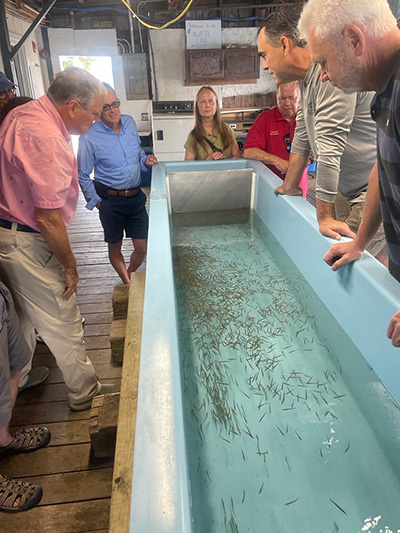RIVER DISCOVERY
Newsletter for the Friends of the Thousand Islands Biological Station
From the Bluff
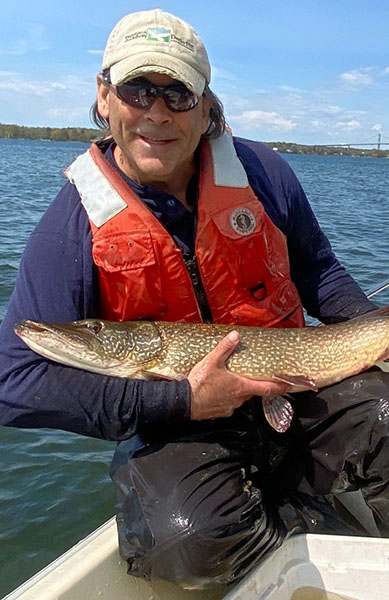
Photo: John Farrell, TIBS Director
Hello Friends! It’s been a busy field season at TIBS and we have some good news about the Muskellunge Recovery Program to report. The release of over 38,000 muskie fry led to much higher abundance of young muskellunge on their nursery grounds. We had many beautiful fish of nearly 10” being observed in surveys. These are the best results we’ve seen in years. We also had a great bunch of students working on our monitoring program and their individual research. Please look inside to learn more about these activities. Of significance is that the TIBS research budget is secured, with two grants awarded that total over $2M! One is funded through NYS DEC Environmental Protection Fund that helps fund the Muskellunge Recovery Project as well as research and monitoring on the river’s Northern Pike and Bass populations for 5 years. The second grant, is through the US Fish and Wildlife Service to continue our successful Fish Habitat Conservation Strategy. There are a number of projects included that improve habitat for Northern Pike and over forty fish species and other wildlife. A new initiative included seeks to better understand walleye spawning habitat in tributaries along eastern Lake Ontario and the river with plans to use this information to create and restore walleye runs in the Thousand Islands Region. We are really excited about the scope of the work and the opportunities it will provide students. Also, we announce a new student scholarship that honors Dr. Robert G. Werner who studied the St. Lawrence in the 1970s through the 1990s and began many of the research efforts that have grown into TIBS and the work we do today. We hope you enjoy this newsletter update and we thank you for your generous support as a TIBS friend!
Muskellunge Dating Service Employed in Population Recovery Effort
In spring 2021, TIBS sampling crews looked for spawning muskellunge from Cape Vincent about 90 miles downstream to near Massena NY to supply eggs and milt in support of an effort to rebuild regional muskellunge populations. Fortunately, we receive help from the US Fish and Wildlife Service who cover weekdays downstream of the Thousand Islands!
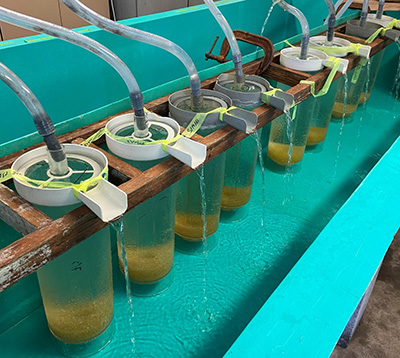
Photo: Fertilized Muskie eggs in incubating in wet lab.
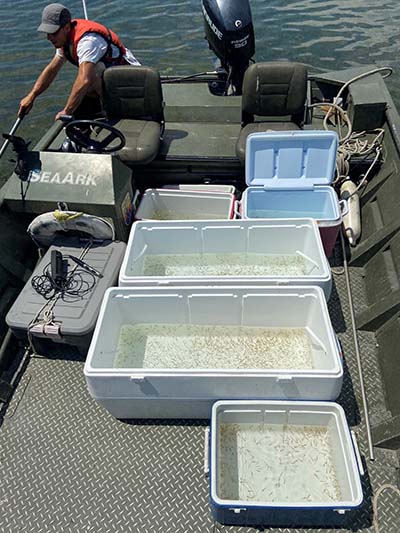
Photo: Transporting lab reared muskies to nursery bays.
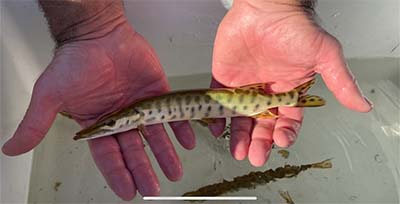 Photo: Young Muskellunge captured by TIBS seining crews, tagged with a mini passive integrated
transponder that will last a lifetime (possibly 20 years or more) and released in
September 2021 as part of the recovery program. Muskies released at 1” as advanced
fry have survived and continue to grow during fall 2021 and indicate that the river’s
nursery habitats can support these fish.
Photo: Young Muskellunge captured by TIBS seining crews, tagged with a mini passive integrated
transponder that will last a lifetime (possibly 20 years or more) and released in
September 2021 as part of the recovery program. Muskies released at 1” as advanced
fry have survived and continue to grow during fall 2021 and indicate that the river’s
nursery habitats can support these fish.
Muskellunge have been threatened by invasive species and a virus. The culprits, Round Goby, a Ponto-Caspian fish that outcompetes native species used as prey and may be an egg predator (Muskies don't guard their eggs like a bass) and viral hemorrhagic septicemia or VHS a pathogen that killed of numerous adult Muskellunge in the mid-2000s. TIBS, funded by NYS DEC and the US Fish and Wildlife Service, monitors the populations and fishery and has witnessed a prolonged decline and is stepping in to try to reverse these trends with experimental stocking. The eggs are fertilized and incubated at TIBS. Sometimes we only see a ripe male or female looking for a mate and we put them together and other times we see a spawning group. We tag fish and keep a database to see if they have been used in past egg takes and if they were, we seek new unique combinations to enhance genetic diversity. With the TIBS Muskie dating service sometimes we will put together a mating group from the Clayton area in Flynn Bay to fish from Lake St. Lawrence. It is all to meet a quota of eggs and a minimum of six unique pairings.
This spring was a great success and nine spawning combinations were achieved and 38,300 Muskie advanced fry (about 1 inch long) were raised at TIBS and released in 44 nursery locations. Crews then followed up later in summer assessing the progress of the babies and we are pleased to report some encouraging results where over half the stocked sites have evidenced of good growth of the young fish. The hope is that they will survive to reach adulthood and develop a homing instinct to spawn again at the same location they were released. Over the next five years of the program a substantial population will be built at the numerous sites. The goal is restoration of sustained natural reproduction - its best when the river does the job! We plan to keep you updated on progress for this important effort and appreciate your support as a friend of TIBS.
The Robert G. Werner Memorial Scholarship

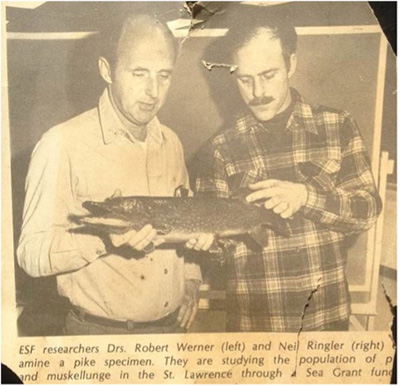
Photo: Bob was awarded a Sea Grant contract to study pike and muskellunge in 1983 that planted a seed for annual aquatic research on the St. Lawrence River that continues today. He also began a contract with NYS DEC in 1987 to study and manage fisheries that has continued for 33 years. The research and monitoring program grew significantly over the years as have the challenging environmental problems. The RGW
During the summer of 1976, Bob and Jo Werner and their family lived on the ESF property
on Governors Island where he studied St. Lawrence River fishes and supported a graduate
research program with NYSDEC. Bob contributed significantly to management and research
on the river beginning with larval fish research as part of the Winter Navigation
Studies in the 1970s and later on pioneering work with Muskellunge and Northern Pike.
This work led to a development of a significant long-term research program and creation
of the Lorraine E. Lewis Thousand Islands Biological Station. More details of his
life and dedication to aquatic sciences were detailed in memoriam published in Fisheries
Magazine here.
The Robert G. Werner Scholarship was established in his honor and to continue his
legacy of student mentoring and conservation. The scholarship fund is awarded annually
to a student doing aquatic research on St. Lawrence River fish ecology. We have a
goal of $25,000 to start in 2022 with the first RGW Scholar so please donate today! Please support the Robert G. Werner Scholarship by logging into https://www.esf.edu/wernerfund/

Photo: Dr. Farrell receives the SUNY ESF Exemplary Researcher award, standing alongside Bob and Steve Lapan, the NYSDEC Great Lakes Fisheries Unit Leader
Dissolved Oxygen and Water Temperature Monitoring on the St. Lawrence River: A Catalyst for Aquatic Life
PhD Student Thornton Ritz
Dissolved oxygen and water temperature are key drivers of the aquatic ecosystem of the St. Lawrence River and are especially important for fish species. Environmental monitoring shows daily and seasonal fluctuations in both of these environmental variables, as well as dissolved oxygen levels reaching hypoxia (dissolved oxygen less than 2 mg/l). Aquatic life may experience negative impacts of low dissolved oxygen around 5 mg/l, however, elevated effects occur with hypoxia, which many species can’t tolerate at all. One of the habitats where dissolved oxygen plays a critical role is in coastal wetlands used for fish spawning and as a nursery habitat for both gamefish and forage fish. These wetlands face many issues including climate change, water regulation, and invasive cattails which often reduce flow and block connected channels. Starting in spring 2021, extensive dissolved oxygen and water temperature monitoring was initiated in two coastal wetlands on the St. Lawrence River. Coinciding with this monitoring, both juvenile and young of year fish were captured as they emigrated to river bays. At Eel Bay 32,000 fish were captured and released comprising 20 different species, such as northern pike, yellow perch, smallmouth bass and largemouth bass. This data demonstrates that wetlands are essential for maintaining fish diversity on the river and providing rearing habitat and prey to support the food web.
Currently, efforts at TIBS are focused on trying to understand how dissolved oxygen and temperature relate to fish movements as young fish develop. We hope to understand if dissolved oxygen and hypoxia triggers fish emigration from wetlands and potentially impacts their survival. Understanding these mechanisms will provide an understanding of how factors such as climate change may impact the fish community of the St. Lawrence River. In collaboration with multiple partners, TIBS has helped restore wetlands and continued monitoring and research will help assess if the methods work. Climate change will likely cause rising temperatures in the river and could decrease dissolved oxygen and further degrade coastal wetland habitat. Finally, these environmental processes may have impacts, including forcing fish movement to refugia, diet shifts, reduced health, body condition, and increased mortality. Moving forward, TIBS will investigate water temperature and hypoxia through continued field work and research on the St. Lawrence River, as well as with experimental work to better understand these processes.
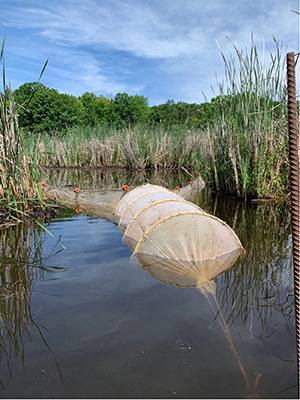
Photo: Monitoring location in a rest ored wetland in Eel Bay, where fish are captured as they exit the marsh in these emigration nets, and loggers set beneath the surface collect temperature and oxygen data continuously
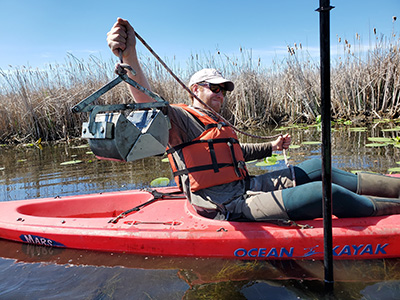
Photo: Thorton Ritz collects bottom sampling with Ponar dredge in a river study wetland
Thanks go to River NGOs for their help in Partnerships
The TIBS Friends Program is underway and we are seeking to grow Friends and provide a stronger connection to current members. We wish to thank those of you that have joined and ask that you spread the word! In this inaugural year, TIBS Friends partnered with three important river organizations to get the word out on the program and we are thankful for their support. Save The River (STR), The Thousand Islands Land Trust (TILT) Visit Tilt page and the Antique Boat Museum (ABM); all initiated email blasts and other forms of communication to their memberships to get the word out about the new Friends program. We have collaborated with STR for decades, especially through the Muskellunge Release Program Visit the Save the River page that along with area guides associations and dedicated anglers led to an increase in voluntary catch and release for muskellunge that aided populations and better management. TIBS has worked alongside TILT for decades, recently partnering on identifying land conservation targets to protect fisheries and river ecology and through TIBS work to plan and evaluate habitat improvement projects on TILT preserves through the Fish Habitat Conservation Strategy. Ongoing work includes connectivity enhancement in invasive cattail dominated sites in large wetlands at Blind Bay, Hammond NY (Tilt - Restoring the Blind Bay).
This summer with the Antique Boat Museum, an ecotour program was launched, where participants visited TIBS at Governors Island and learned about our research on the river. We hope to continue these efforts in 2022 and involve you, as a current Friend in many upcoming opportunities. Thanks for your support!

Photo: ABM Antique Boat Zipper visit's TIBS at Governors Island for Ecotour in August 2021
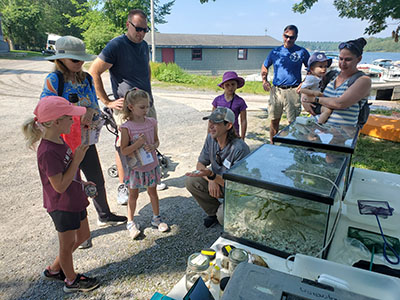
Photo: In August 2021, TIBS staff brought fish and educational material for the Healthy Land = Healthy River TILT Trek. The kids and participants had fun learning about the river and the TIBS programs.
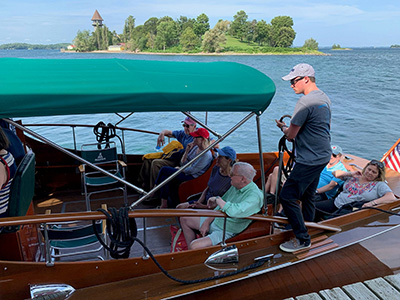
Photo: TIBS friends in Antique Boat Zipper
TIBS Scientific Breakthroughs
In future issues of River Discovery, we will use this section to describe and interpret scientific advancements from our recent journal publications. Why is it so important to publish in scientific journals?
The process of science can be boiled down to making observations and asking specific questions to be tested. We then collect data, take measurements, run experiments, make tests, and conduct analyses, many times looking at the problem from different perspectives over long periods of time. An example could be asking what processes drive the fluctuations in fish populations over time? How will an invasive species influence native species? Can we restore functional habitat for biota? When we learn something of importance it is presented in a manuscript in a painstakingly thorough process to be submitted to a respected scientific journal to be considered for publication. Following a submission, the nail biting begins in anticipation of the red ink to follow. How will they react to our work? Independent expert reviewers, associate and chief editors comb through the manuscript and make criticisms of all aspects of the research and a decision is made: reject, revise and resubmit or accept (rarely is accept the first outcome). The process, after the years of study, can take months to over a year! Moreover, unlike other publishing such as popular books, the authors generally have to pay to get their work published! Why would anyone want to do this? The peer-review publication process institutes a series of checks and balances in sorting out what is good science. It is not always perfect but it guides our progress and provides a standard. When we are successful the article is another building block in our current understanding of the problem. A body of scientific work developed by an individual is used as a measure of professional advancement and an important career milestone that can influence promotion and tenure decisions and future funding opportunities. For an institution such as TIBS, publication represents our direction, focus, interests, helps build our reputation, and guides of our mission for the conservation work we do.
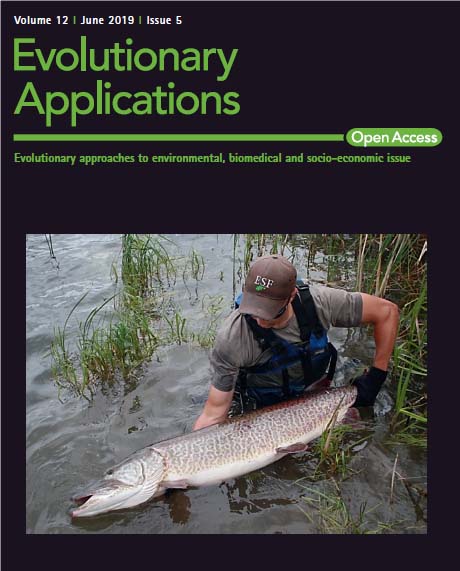
Photo: A recent TIBS Research publication that was used as a cover for the Journal Evolutionary Applications in 2019
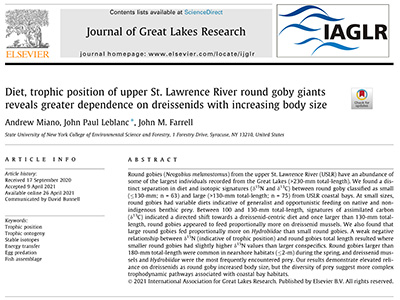
Photo: An example recent publication from TIBS students and staff that examined what invasive round gobies eat as they increase in size. The Thousand Islands has some of the largest goby that can be found in the Great Lakes.
Major Donor Giving Opportunities
As a major donor to TIBS, you will be leading the charge to secure the future of TIBS and the future of our students. Major sponsors have the opportunity to directly contribute to several critical fundraising needs to support the longevity of the station and our programs. For more information on how you can support TIBS as a Major sponsor contact :
Brandy Neveldine
ESF Development Office
[email protected]
(315) 470-6683
